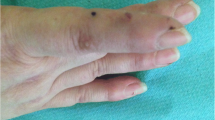Summary
The idiopathic hypereosinophilic syndrome (HES) comprises a heterogeneous group of disorders with unknown pathogenesis characterized by persistent peripheral blood and bone marrow eosinophilia and eosinophil infiltrates of multiple organs, leading to severe organ dysfunction. Lymphokine-mediated T-lymphocyte control of human eosinophilic granulopoiesis is thought to play a major role in the pathogenesis of HES. Treatment of this disease with cyclosporin-A (CSA) therefore appears to be sensible. We report the case of a patient with a severe HES who failed to respond adequately to glucocorticoid treatment. With additional CSA therapy, disease activity showed a favorable remission and eosinophil counts rapidly decreased to the normal range and remained normal even after reduction of the methylprednisolone dosage to 7.5 mg daily. To date his remission has continued for more than 6 months. In the meantime we have confirmed the beneficial effects of CSA in two other cases of HES. This suggests that CSA treatment is justified, at least in combination with glucocorticoids, in severe cases of HES to prevent the side effects of a longlasting high-dose glucocorticoid therapy.
Similar content being viewed by others
References
DaSilva MAP, Heerema N, Schwenk GR, Hoffman R (1988) Evidence for the clonal nature of hypereosinophilic syndrome. Cancer Genet Cytogenet 32: 109–115
Fauci AS, Harley JB, Roberts WV et al. (1982) The idiopathic hypereosinophilic syndrome. Ann Intern Med 97: 78–92
Flaum MA, Schooley RT, Fauci AS, Gralnick HR (1981) A clinicopathologic correlation of the idiopathic hypereosinophilic syndrome. I. Hematologic manifestations. Blood 58: 1012–1020
Herold KC, Laucki DW, Moldvin RL, Fitch FW (1986) Immunosuppressive effects of cyclosporin A on cloned T cells. J Immunol 136: 1315–1321
Parillo JE, Fauci AS, Wolff SM (1978) Therapy of the hypereosinophilic syndrome. Ann Intern Med 89: 167–172
Raghavachar A, Fleischer S, Frickhofen N, Heimpel H, Fleischer B (1987) T-lymphocyte control of human eosinophilic granulopoiesis: clonal analysis in an idiopathic hypereosinophilic syndrome. J Immunol 139: 3753–3758
Schooley RT, Flaum MA, Gralnick HR, Fauci AS (1981) A clinicopathologic correlation of the idiopathic hypereosinophilic syndrome. II. Clinical manifestations. Blood 58: 1021–1026
Author information
Authors and Affiliations
Rights and permissions
About this article
Cite this article
Zabel, P., Schlaak, M. Cyclosporin for hypereosinophilic syndrome. Ann Hematol 62, 230–231 (1991). https://doi.org/10.1007/BF01729838
Received:
Accepted:
Issue Date:
DOI: https://doi.org/10.1007/BF01729838




